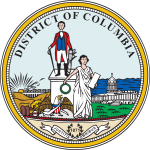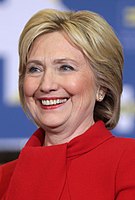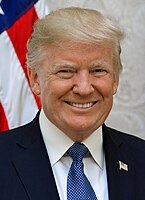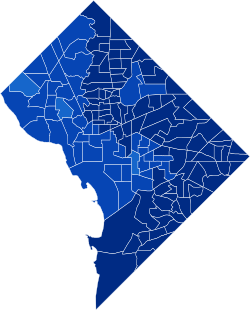2016 United States presidential election in the District of Columbia
| ||||||||||||||||||||||||||
| Turnout | 65.3% | |||||||||||||||||||||||||
|---|---|---|---|---|---|---|---|---|---|---|---|---|---|---|---|---|---|---|---|---|---|---|---|---|---|---|
| ||||||||||||||||||||||||||
Clinton 70–80% 80–90% 90-100%
| ||||||||||||||||||||||||||
| ||||||||||||||||||||||||||
| Elections in the District of Columbia |
|---|
 |
The 2016 United States presidential election in the District of Columbia was held on Tuesday, November 8, 2016, as part of the 2016 United States presidential election in which all fifty states and the District of Columbia participated. District of Columbia voters chose electors to represent them in the Electoral College via a popular vote, pitting the Republican Party's nominee, businessman Donald Trump, and running mate Indiana Governor Mike Pence against Democratic Party nominee, former Secretary of State Hillary Clinton, and her running mate Virginia Senator Tim Kaine. The District of Columbia has three electoral votes in the Electoral College.[1] Prior to the election, Clinton was considered to be virtually certain to win Washington DC.
Clinton won the election with 282,830 votes, or 90.9%, thereby becoming the first presidential candidate to win over 95% of the district's two-party vote. Trump received 12,723 votes, or 4.1%,[2] which is both the lowest popular vote total and the lowest share of the vote received by any Republican candidate since voters in the District were granted presidential electors under the Twenty-third Amendment.
Notably, Clinton's 86.77-point margin of victory also represented the largest secured by any major-party presidential candidate, in any jurisdiction, since Franklin D. Roosevelt's landslide re-election in 1944 in Mississippi. It is the largest ever in the district. Trump's 4.1% is the lowest vote share for a major party nominee since Thomas E. Dewey in that same election, and the lowest ever in the district. Along with 11 other states, the District of Columbia shifted towards the Democrats in this election.[3]
Primary elections
[edit]The incumbent President of the United States, Barack Obama, a Democrat and former U.S. Senator from Illinois, was first elected president in the 2008 election, running with former Senator Joe Biden of Delaware. Defeating the Republican nominee, Senator John McCain of Arizona, with 52.9% of the popular vote and 68% of the electoral vote,[4][5] Obama succeeded two-term Republican President George W. Bush, the former Governor of Texas. Obama and Biden were reelected in the 2012 presidential election, defeating former Massachusetts Governor Mitt Romney with 51.1% of the popular vote and 61.7% of electoral votes.[6] Although Barack Obama's approval rating in the RealClearPolitics poll tracking average remained between 40 and 50 percent for most of his second term, it experienced a surge in early 2016 and reached its highest point since 2012 during June of that year.[7][8] Analyst Nate Cohn noted that a strong approval rating for President Obama would equate to a strong performance for the Democratic candidate, and vice versa.[9]
Following his second term, President Obama was not eligible for another reelection. In October 2015, his running-mate and two-term Vice President Biden decided not to enter the race for the Democratic presidential nomination either.[10] With their term expiring on January 20, 2017, the electorate was asked to elect a new president, the 45th president and 48th vice president of the United States, respectively.
Republican convention
[edit]Due to the small geographical size of the District of Columbia and the very small number of Republicans in the District, the local Republican party decided go directly to a "state convention", which took place at the Loews Madison Hotel at 1177 15th St NW from 10 a.m. – 4 p.m. The Convention/Caucus method was chosen because the June 14th primary was deemed too late, and DC would be penalized and only get 16 delegates.[11]
| Candidate | Votes | Percentage | Actual delegate count | ||
|---|---|---|---|---|---|
| Bound | Unbound | Total | |||
| Marco Rubio | 1,059 | 37.3% | 10 | 0 | 10 |
| John Kasich | 1,009 | 35.54% | 9 | 0 | 9 |
| Donald Trump | 391 | 13.77% | 0 | 0 | 0 |
| Ted Cruz | 351 | 12.36% | 0 | 0 | 0 |
| Jeb Bush (withdrawn) | 14 | 0.49% | 0 | 0 | 0 |
| Rand Paul (withdrawn) | 12 | 0.42% | 0 | 0 | 0 |
| Ben Carson (withdrawn) | 3 | 0.11% | 0 | 0 | 0 |
| Unprojected delegates: | 0 | 0 | 0 | ||
| Total: | 2,839 | 100% | 19 | 0 | 19 |
| Source: The Green Papers | |||||
Democratic primary
[edit]
The Democratic primary was held June 14. The date was chosen because it was thought that by then the race would be over and the voters could then concentrate on local races.
Results
[edit]| Candidate | Popular vote | Estimated delegates | |||
|---|---|---|---|---|---|
| Count | Percentage | Pledged | Unpledged | Total | |
| Hillary Clinton | 76,704 | 77.95% | 16 | 23 | 39 |
| Bernie Sanders | 20,361 | 20.69% | 4 | 2 | 6 |
| Roque "Rocky" De La Fuente | 213 | 0.22% | |||
| Under votes | 611 | 0.62% | |||
| Write-in | 485 | 0.49% | |||
| Over votes | 24 | 0.02% | |||
| Uncommitted | — | 0 | 0 | 0 | |
| Total | 98,398 | 100% | 20 | 25 | 45 |
| Source: [12][13] | |||||
By ward
[edit]| County [14] | Clinton | Votes | Sanders | Votes | Totals | TO% |
|---|---|---|---|---|---|---|
| Ward 1 | 73.8% | 9,893 | 25.3% | 3,181 | 12,563 | 24.34% |
| Ward 2 | 79.6% | 7,294 | 19.4% | 1,777 | 9,164 | 25.29% |
| Ward 3 | 77.1% | 10,893 | 21.8% | 3,087 | 14,135 | 32.00% |
| Ward 4 | 77.9% | 12,863 | 20.7% | 3,421 | 16,516 | 29.46% |
| Ward 5 | 78.2% | 9,214 | 20.5% | 2,419 | 11,779 | 19.89% |
| Ward 6 | 77.9% | 11,898 | 20.9% | 3,198 | 15,275 | 24.89% |
| Ward 7 | 82.1% | 8,657 | 16.2% | 1,707 | 10,548 | 18.82% |
| Ward 8 | 78.6% | 6,612 | 18.7% | 1,571 | 8,418 | 15.17% |
| Total | 78.0% | 76,704 | 20.7% | 20,361 | 98,398 | 23.42% |
Ballot controversy
[edit]On March 30, ten weeks ahead of the Washington D.C. primary, NBC affiliate News 4 reported that the Democratic Party's D.C. State Committee had submitted registration paperwork for listing presidential candidate Bernie Sanders on the primary ballots a day late, even though the Sanders campaign had correctly and timely registered with the state party. After a voter filed a challenge, this would possibly lead to Sanders' name being missing on the ballots.[15] As the D.C. Council announced it would hold an emergency vote to put Sanders back on the ballots,[16] and with Clinton's campaign chairman John Podesta asking to make sure an administrative error wouldn't exclude a candidate, D.C. Democratic Party chairwoman Anita Bonds told CNN that "Bernie will be on the ballot." She further explained that the party has always notified the D.C. board of elections a day after the deadline, with the only difference being that this time, someone challenged the inclusion of Sanders.[17]
General election
[edit]Voting history
[edit]The Twenty-third Amendment to the United States Constitution, ratified in 1961, grants the District of Columbia the right to choose presidential electors equal to the number from the least populous state (currently Wyoming's three). Since the amendment's ratification, the District of Columbia has cast its electoral votes for the Democratic candidate in every election. A Republican has never been the District's Mayor, and the current Council has 10 Democrats and two Independents.
Predictions
[edit]| Source | Ranking | As of |
|---|---|---|
| Los Angeles Times[18] | Safe D | November 6, 2016 |
| CNN[19] | Safe D | November 4, 2016 |
| Cook Political Report[20] | Safe D | November 7, 2016 |
| Electoral-vote.com[21] | Safe D | November 8, 2016 |
| Sabato's Crystal Ball[22] | Safe D | November 7, 2016 |
| Fox News[23] | Safe D | November 7, 2016 |
Results
[edit]| 2016 United States presidential election in the District of Columbia[24] | |||||||||
|---|---|---|---|---|---|---|---|---|---|
| Party | Candidate | Running mate | Popular vote | Electoral vote | Swing | ||||
| Count | % | Count | % | ||||||
| Democratic | Hillary Clinton of New York | Tim Kaine of Virginia | 282,830 | 90.86% | 3 | 100.00% | |||
| Republican | Donald Trump of New York | Mike Pence of Indiana | 12,723 | 4.09% | 0 | 0.00% | |||
| Independent | Write-in of | Write-in of | 6,551 | 2.10% | 0 | 0.00% | |||
| Libertarian | Gary Johnson of New Mexico | Bill Weld of Massachusetts | 4,906 | 1.58% | 0 | 0.00% | |||
| Green | Jill Stein of Massachusetts | Ajamu Baraka of Illinois | 4,258 | 1.37% | 0 | 0.00% | |||
| Total | 311,268 | 100.00% | 3 | 100.00% | |||||
Results by Ward
[edit]| Ward | Hillary Clinton
Democratic |
Donald Trump
Republican |
Other Candidates
Various Parties[a] |
Margin | Total Votes Cast | ||||
|---|---|---|---|---|---|---|---|---|---|
| # | % | # | % | # | % | # | % | ||
| Ward 1 | 37,490 | 92.50% | 1,066 | 2.63% | 1,973 | 4.87% | 35,517 | 87.63% | 40,529 |
| Ward 2 | 28,714 | 86.59% | 2,304 | 6.95% | 2,143 | 6.46% | 26,410 | 79.64% | 33,161 |
| Ward 3 | 36,475 | 85.66% | 3,323 | 7.80% | 2,784 | 6.54% | 33,152 | 77.86% | 42,582 |
| Ward 4 | 37,962 | 92.60% | 1,358 | 3.31% | 1,677 | 4.09% | 36,285 | 88.51% | 40,997 |
| Ward 5 | 37,021 | 92.72% | 1,141 | 2.86% | 1,766 | 4.42% | 35,255 | 88.30% | 39,928 |
| Ward 6 | 45,540 | 88.11% | 2,506 | 4.85% | 3,641 | 7.04% | 41,899 | 81.07% | 51,687 |
| Ward 7 | 31,784 | 95.47% | 547 | 1.64% | 961 | 2.89% | 30,823 | 92.58% | 33,292 |
| Ward 8 | 27,844 | 95.71% | 478 | 1.64% | 770 | 2.65% | 27,074 | 93.06% | 29,092 |
| Total | 282,830 | 90.86% | 12,723 | 4.09% | 15,715 | 5.05% | 267,115 | 85.81% | 311,268 |
See also
[edit]Notes
[edit]- ^ This category consists of the cumulative vote totals of Gary Johnson, Jill Stein, and all other write-in votes, which, when combined, has a higher vote total than Donald Trump. However, separately, none of the three mentioned above got more.
References
[edit]- ^ "Distribution of Electoral Votes". National Archives and Records Administration. September 19, 2019. Retrieved November 23, 2020.
- ^ "General Election 2016 – Unofficial Results". Retrieved November 10, 2016.
- ^ "District Of Columbia Presidential Election Voting History". Retrieved October 8, 2018.
- ^ "United States House of Representatives floor summary for Jan 8, 2009". Clerk.house.gov. Archived from the original on April 2, 2012. Retrieved January 30, 2009.
- ^ "Federal elections 2008" (PDF). Federal Election Commission. Retrieved May 11, 2015.
- ^ "President Map". The New York Times. November 29, 2012. Retrieved May 11, 2015.
- ^ "Election Other – President Obama Job Approval". RealClearPolitics. Retrieved December 24, 2015.
- ^ Byrnes, Jesse (June 15, 2016). "Poll: Obama approval rating highest since 2012". TheHill. Retrieved June 19, 2016.
- ^ Cohn, Nate (January 19, 2015). "What a Rise in Obama's Approval Rating Means for 2016". The New York Times. ISSN 0362-4331. Retrieved June 19, 2016.
- ^ "Joe Biden Decides Not to Enter Presidential Race". The Wall Street Journal. Retrieved October 21, 2015.
- ^ "With Their Presidential Primary On Saturday, D.C. Republicans Finally Have A Big Say In Something: DCist". Archived from the original on March 14, 2016. Retrieved March 13, 2016.
- ^ The Green Papers
- ^ District of Columbia Board of Elections – Official Primary Results
- ^ "Primarias Presidenciales Dem贸cratas 2016 - Comisi贸n Estatal de Elecciones". Democratas2016.ceepur.org. Retrieved March 19, 2022.
- ^ Tom Sherwood (March 30, 2016). "Bernie Sanders May Be Off DC Ballot After Democratic Party Filing". NBC 4 Washington. Retrieved April 1, 2016.
- ^ Tom Sherwood (March 31, 2016). "DC to Hold Emergency Vote to Get Bernie Sanders on Democratic Primary Ballot". NBC 4 Washington. Retrieved April 1, 2016.
- ^ Tom LoBlanco (March 31, 2016). "Sanders likely on D.C. ballot despite challenge". CNN. Retrieved April 1, 2016.
- ^ "Our final map has Clinton winning with 352 electoral votes. Compare your picks with ours". Los Angeles Times. November 6, 2016. Retrieved November 13, 2016.
- ^ Chalian, David (November 4, 2016). "Road to 270: CNN's new election map". CNN. Retrieved March 3, 2019.
- ^ "2016 Electoral Scorecard". The Cook Political Report. November 7, 2016. Archived from the original on February 16, 2017. Retrieved March 3, 2019.
- ^ "2016 Electoral Map Prediction". Electoral-vote.com. November 8, 2016. Retrieved March 3, 2019.
- ^ Sabato, Larry J. (November 7, 2016). "2016 President". University of Virginia Center for Politics. Retrieved March 3, 2019.
- ^ "Electoral Scorecard: Map shifts again in Trump's favor, as Clinton holds edge". Fox News. November 7, 2016. Retrieved November 13, 2016.
- ^ https://www.nytimes.com/elections/results/district-of-columbia NY Times
- ^ "Our Campaigns - DC US President Race - Nov 08, 2016". www.ourcampaigns.com. Retrieved January 25, 2025.





